Effects of Pig Manure Compost Application Timing (Spring/Autumn) on N2O Emissions and Maize Yields in Northeast China
Abstract
1. Introduction
2. Materials and Methods
2.1. Study Area and Soil Properties
2.2. Field Experiment
2.3. Gas Sampling and N2O Analysis
2.4. Collection and Analysis of Soil Samples
2.5. Data Analysis
3. Results
3.1. Soil Mineral N
3.2. Maize Grain Yields and Aboveground Biomasses
3.3. N2O Emissions
3.4. Yield-Scaled N2O Emissions
4. Discussion
4.1. The Effect of Composted Manure Application Timing on N2O Emissions
4.2. The Effect of Manure Compost Application Timing on Maize Yields
4.3. The Effect of Manure Application Timing on Yield-Scaled N2O Emissions
5. Conclusions
Author Contributions
Funding
Data Availability Statement
Conflicts of Interest
References
- Li, H.; Feng, W.-t.; He, X.-h.; Zhu, P.; Gao, H.-j.; Sun, N.; Xu, M.-g. Chemical fertilizers could be completely replaced by manure to maintain high maize yield and soil organic carbon (SOC) when SOC reaches a threshold in the Northeast China Plain. J. Integr. Agric. 2017, 16, 937–946. [Google Scholar] [CrossRef]
- Xu, H.; Mustafa, A.; Saeed, Q.; Jiang, G.; Sun, N.; Liu, K.; Kucerik, J.; Yang, X.; Xu, M. Combined application of chemical and organic fertilizers enhances soil organic carbon sequestration and crop productivity by improving carbon stability and management index in a rice–rice cropping system. Chem. Biol. Technol. Agric. 2025, 12, 1. [Google Scholar] [CrossRef]
- Liu, C.; Wang, K.; Meng, S.; Zheng, X.; Zhou, Z.; Han, S.; Chen, D.; Yang, Z. Effects of irrigation, fertilization and crop straw management on nitrous oxide and nitric oxide emissions from a wheat–maize rotation field in northern China. Agric. Ecosyst. Environ. 2011, 140, 226–233. [Google Scholar] [CrossRef]
- Meng, L.; Ding, W.; Cai, Z. Long-term application of organic manure and nitrogen fertilizer on N2O emissions, soil quality and crop production in a sandy loam soil. Soil Biol. Biochem. 2005, 37, 2037–2045. [Google Scholar] [CrossRef]
- Zhai, L.-m.; Liu, H.-b.; Zhang, J.-z.; Huang, J.; Wang, B.-r. Long-Term Application of Organic Manure and Mineral Fertilizer on N2O and CO2 Emissions in a Red Soil from Cultivated Maize-Wheat Rotation in China. Agric. Sci. China 2011, 10, 1748–1757. [Google Scholar] [CrossRef]
- Sigdel, S.; Dell, C.J.; Karsten, H.D. Can manure application method and timing with cover crops reduce NH3 and N2O gas losses and sustain corn yield? Agron. J. 2024, 116, 2242–2262. [Google Scholar] [CrossRef]
- IPCC. Chapter 8: Agricultural. In Climate Change 2007: Mitigation. In Contribution of Working Group III to the Fourth Assessment Report of the Intergovernmental Panel on Climate Change; Metz, B., Davidson, O., Bosch, P., Dave, R., Meyer, L., Eds.; Cambridge University Press: Cambridge, UK; New York, NY, USA, 2007; pp. 497–540. [Google Scholar]
- Meng, X.; Ma, C.; Petersen, S.O. Sensitive control of N2O emissions and microbial community dynamics by organic fertilizer and soil interactions. Biol. Fertil. Soils 2022, 58, 771–788. [Google Scholar] [CrossRef]
- Kurganova, I.N.; Lopes de Gerenyu, V.O. Effect of the temperature and moisture on the N2O emission from some arable soils. Eurasian Soil Sci. 2010, 43, 919–928. [Google Scholar] [CrossRef]
- Robertson, G.P.; Paul, E.A.; Harwood, R.R. Greenhouse gases in intensive agriculture: Contributions of individual gases to the radiative forcing of the atmosphere. Science 2000, 289, 1922–1925. [Google Scholar] [CrossRef] [PubMed]
- Davidson, E.A. The contribution of manure and fertilizer nitrogen to atmospheric nitrous oxide since 1860. Nat. Geosci. 2009, 2, 659–662. [Google Scholar] [CrossRef]
- Mori, A.; Hojito, M. Effect of combined application of manure and fertilizer on N2O fluxes from a grassland soil in Nasu, Japan. Agric. Ecosyst. Environ. 2012, 160, 40–50. [Google Scholar] [CrossRef]
- Rochette, P.; Angers, D.A.; Chantigny, M.H.; Bertrand, N.; Côté, D. Carbon dioxide and nitrous oxide emissions following fall and spring applications of pig slurry to an agricultural soil. Soil Sci. Soc. Am. J. 2004, 68, 1410–1420. [Google Scholar] [CrossRef]
- Beckwith, C.P.; Cooper, J.; Smith, K.A.; Shepherd, M.A. Nitrate leaching loss following application of organic manures to sandy soils in arable cropping I. Effects of application time, manure type, overwinter crop cover and nitrification inhibition. Soil Use Manag. 1998, 14, 123–130. [Google Scholar] [CrossRef]
- Smith, K.A.; Beckwith, C.P.; Chalmers, A.G.; Jackson, D.R. Nitrate leaching following autumn and winter application of animal manures to grassland. Soil Use Manag. 2002, 18, 428–434. [Google Scholar] [CrossRef]
- Hansen, E.M.; Thomsen, I.K.; Hansen, M.N. Optimizing farmyard manure utilization by varying the application time and tillage strategy. Soil Use Manag. 2004, 20, 173–177. [Google Scholar] [CrossRef]
- Van Es, H.M.; Schindelbeck, R.R.; Jokela, W.E. Effect of manure application timing, crop, and soil type on phosphorus leaching. J. Environ. Qual. 2004, 33, 1070–1080. [Google Scholar] [CrossRef] [PubMed]
- Lemke, R.L.; Izaurralde, R.C.; Nyborg, M. Seasonal distribution of nitrous oxide emissions from soils in the parkland region. Soil Sci. Soc. Am. J. 1998, 62, 1320–1326. [Google Scholar] [CrossRef]
- Wagner-Riddle, C.; Thurtell, G.W. Nitrous oxide emissions from agricultural fields during winter and spring thaw as affected by management practices. Nutr. Cycl. Agroecosyst. 1998, 52, 151–163. [Google Scholar] [CrossRef]
- Hernandez-Ramirez, G.; Brouder, S.M.; Smith, D.R.; Van Scoyoc, G.E. Greenhouse gas fluxes in an eastern corn belt soil: Weather, nitrogen source, and rotation. J. Environ. Qual. 2009, 38, 841–854. [Google Scholar] [CrossRef]
- Lin, S.; Hernandez-Ramirez, G.; Kryzanowski, L.; Lohstraeter, G.; Wallace, T. Adding inhibitors to manure injections can mitigate nitrous oxide emissions from barley croplands. Nutr. Cycl. Agroecosyst. 2023, 126, 81–100. [Google Scholar] [CrossRef]
- Lin, S.; Hernandez-Ramirez, G.; Kryzanowski, L.; Wallace, T.; Grant, R.; Degenhardt, R.; Berger, N.; Lohstraeter, G.; Powers, L.-A. Timing of manure injection and nitrification inhibitors impacts on nitrous oxide emissions and nitrogen transformations in a barley crop. Soil Sci. Soc. Am. J. 2017, 81, 1595–1605. [Google Scholar] [CrossRef]
- Ponce de León, M.A.; Dell, C.J.; Karsten, H.D. Nitrous oxide emissions from manured, no-till corn systems. Nutr. Cycl. Agroecosyst. 2021, 119, 405–421. [Google Scholar] [CrossRef]
- Maris, S.C.; Abalos, D.; Capra, F.; Moscatelli, G.; Scaglia, F.; Cely Reyes, G.E.; Ardenti, F.; Boselli, R.; Ferrarini, A.; Mantovi, P.; et al. Strong potential of slurry application timing and method to reduce N losses in a permanent grassland. Agric. Ecosyst. Environ. 2021, 311, 107329. [Google Scholar] [CrossRef]
- Wood, M.D.; Gao, X.; Tiessen, K.H.D.; Tenuta, M.; Flaten, D.N. Enhanced efficiency urea fertilizers and timing effects on N2O emissions from spring wheat production in Manitoba. Agron. J. 2024, 116, 51–72. [Google Scholar] [CrossRef]
- Sherman, J.F.; Young, E.O.; Jokela, W.E.; Cavadini, J. Impacts of low-disturbance dairy manure incorporation on ammonia and greenhouse gas fluxes in a corn silage–winter rye cover crop system. J. Environ. Qual. 2021, 50, 836–846. [Google Scholar] [CrossRef] [PubMed]
- Wagner-Riddle, C.; Hu, Q.C.; Van Bochove, E.; Jayasundara, S. Linking nitrous oxide flux during spring thaw to nitrate denitrification in the soil profile. Soil Sci. Soc. Am. J. 2008, 72, 908–916. [Google Scholar] [CrossRef]
- Wolf, B.; Zheng, X.; Bruggemann, N.; Chen, W.; Dannenmann, M.; Han, X.; Sutton, M.A.; Wu, H.; Yao, Z.; Butterbach-Bahl, K. Grazing-induced reduction of natural nitrous oxide release from continental steppe. Nature 2010, 464, 881–884. [Google Scholar] [CrossRef]
- Priemé, A.; Christensen, S. Natural perturbations, drying–wetting and freezing–thawing cycles, and the emission of nitrous oxide, carbon dioxide and methane from farmed organic soils. Soil Biol. Biochem. 2001, 33, 2083–2091. [Google Scholar] [CrossRef]
- Dong, D.; Kou, Y.; Yang, W.; Chen, G.; Xu, H. Effects of urease and nitrification inhibitors on nitrous oxide emissions and nitrifying/denitrifying microbial communities in a rainfed maize soil: A 6-year field observation. Soil Tillage Res. 2018, 180, 82–90. [Google Scholar] [CrossRef]
- Dong, D.; Yang, W.; Sun, H.; Kong, S.; Xu, H. Effects of animal manure and nitrification inhibitor on N2O emissions and soil carbon stocks of a maize cropping system in Northeast China. Sci. Rep. 2022, 12, 15202. [Google Scholar] [CrossRef]
- Dong, D.; Yang, W.; Sun, H.; Kong, S.; Xu, H. Nitrous oxide emissions in response to long-term application of the nitrification inhibitor DMPP in an acidic luvisol. Appl. Soil Ecol. 2021, 159, 103861. [Google Scholar] [CrossRef]
- Randall, G.W.; Schmitt, M.A.; Schmidt, J.P. Corn Production as Affected by Time and Rate of Manure Application and Nitrapyrin. J. Prod. Agric. 1999, 12, 317–323. [Google Scholar] [CrossRef]
- Rochette, P.; Angers, D.A.; Chantigny, M.H.; Gagnon, B.; Bertrand, N. N2O fluxes in soils of contrasting textures fertilized with liquid and solid dairy cattle manures. Can. J. Soil Sci. 2008, 88, 175–187. [Google Scholar] [CrossRef]
- Isbell, S.A.; Bradley, B.A.; Morris, A.H.; Wallace, J.M.; Kaye, J.P. Nitrogen dynamics in grain cropping systems integrating multiple ecologically based management strategies. Ecosphere 2021, 12, e03380. [Google Scholar] [CrossRef]
- Thomsen, I.K. Crop N utilization and leaching losses as affected by time and method of application of farmyard manure. Eur. J. Agron. 2005, 22, 1–9. [Google Scholar] [CrossRef]
- Van Groenigen, J.W.; Velthof, G.L.; Oenema, O.; Van Groenigen, K.J.; Van Kessel, C. Towards an agronomic assessment of N2O emissions: A case study for arable crops. Eur. J. Soil Sci. 2010, 61, 903–913. [Google Scholar] [CrossRef]
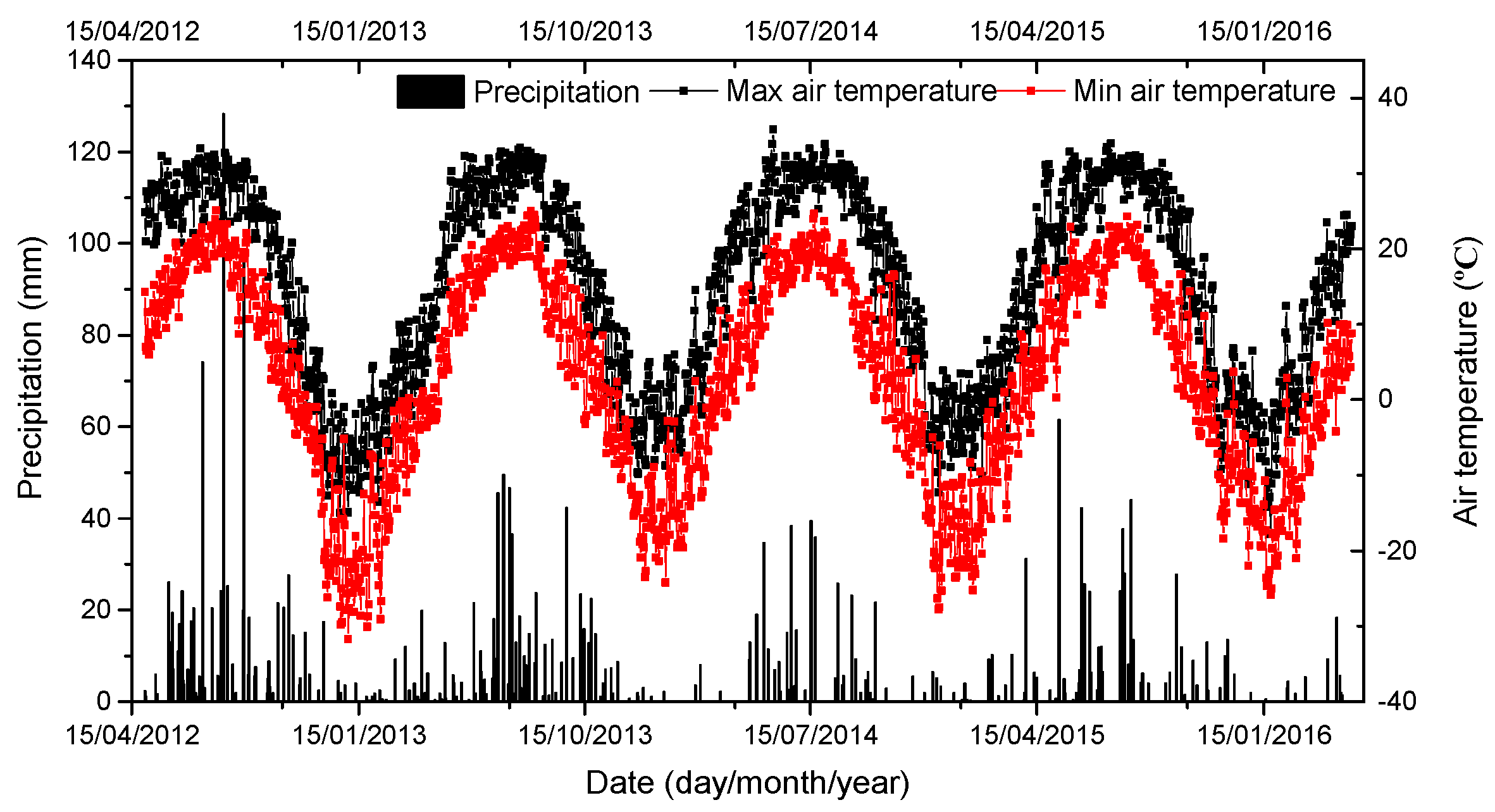
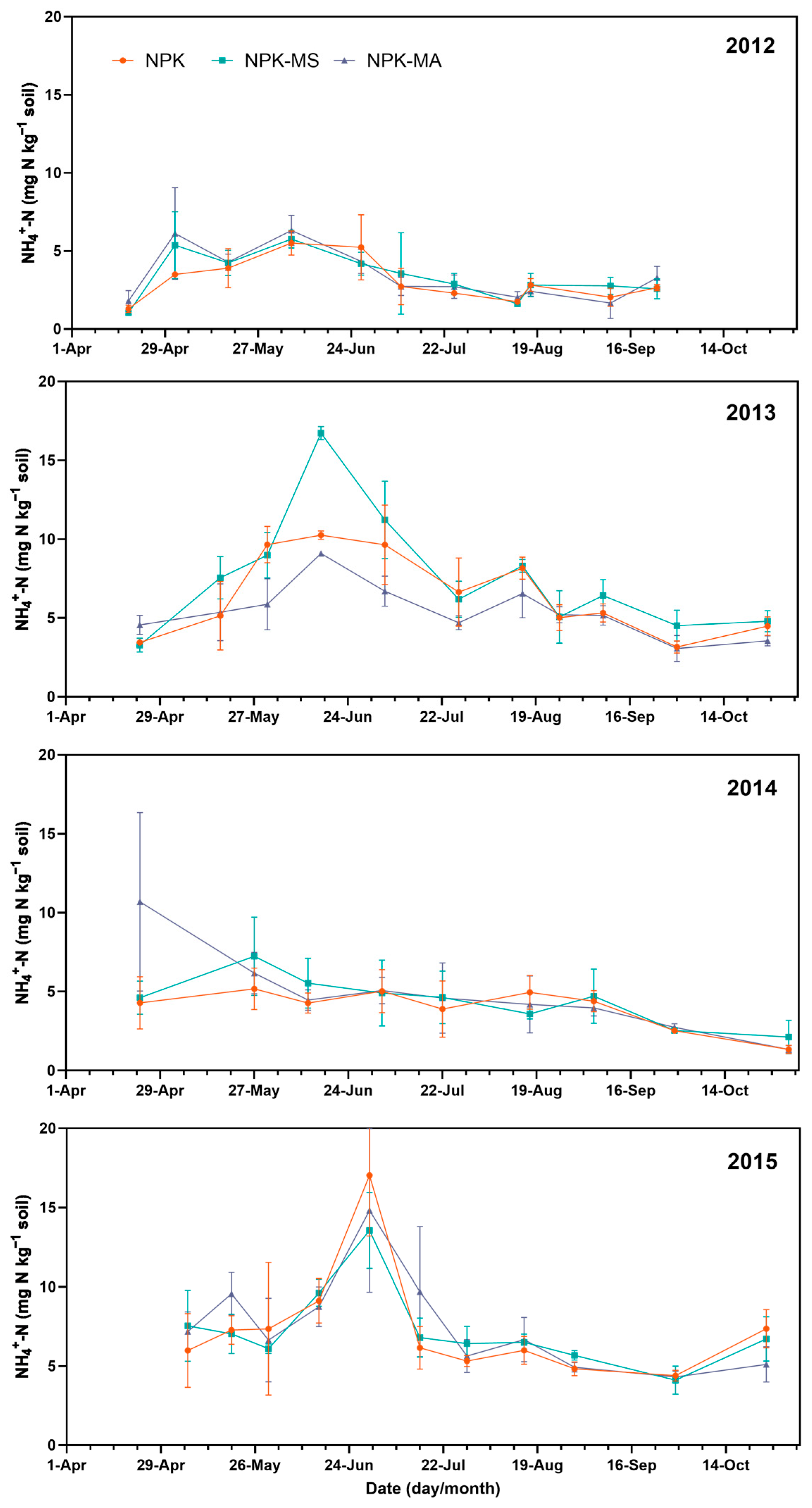
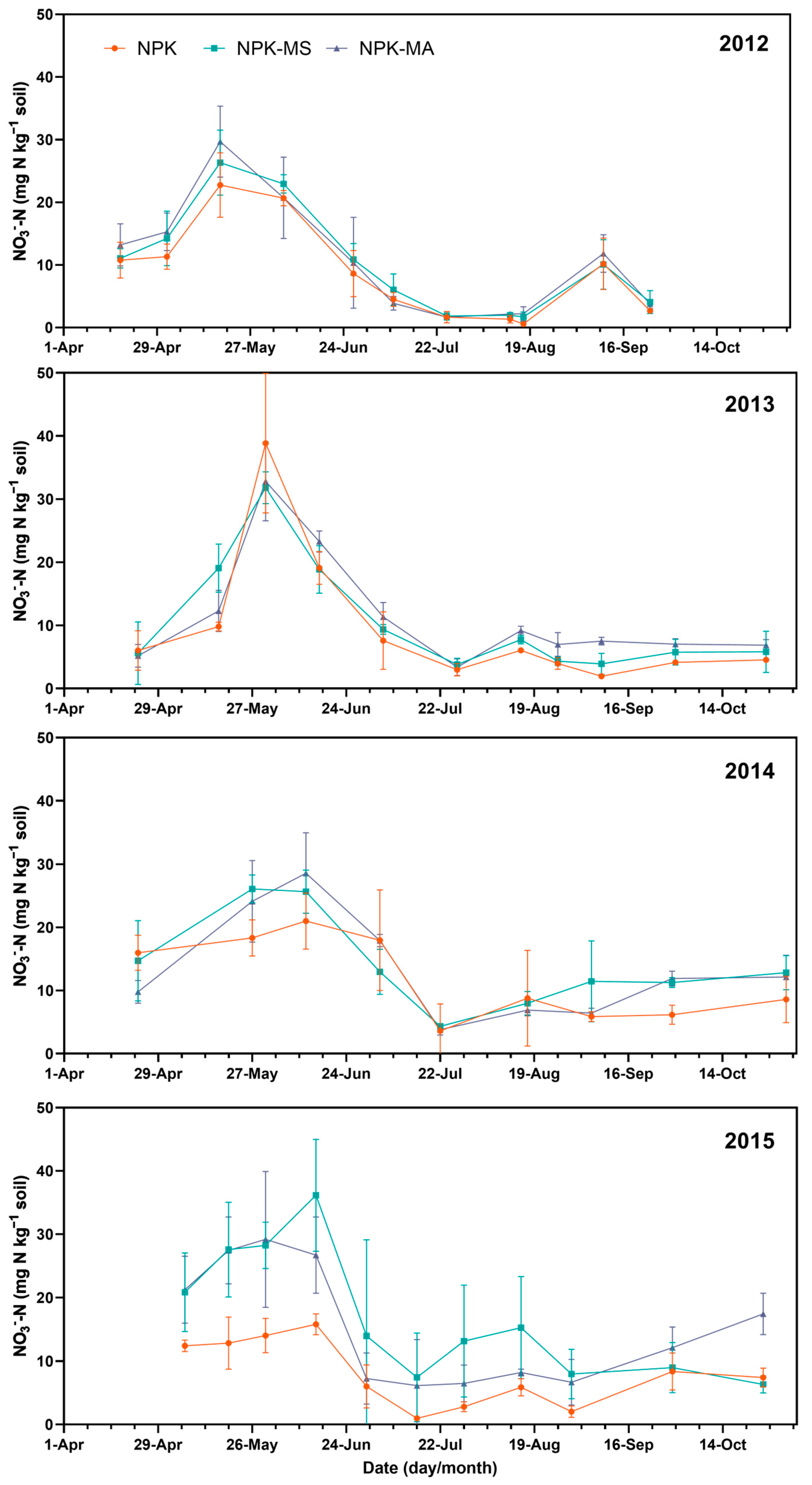
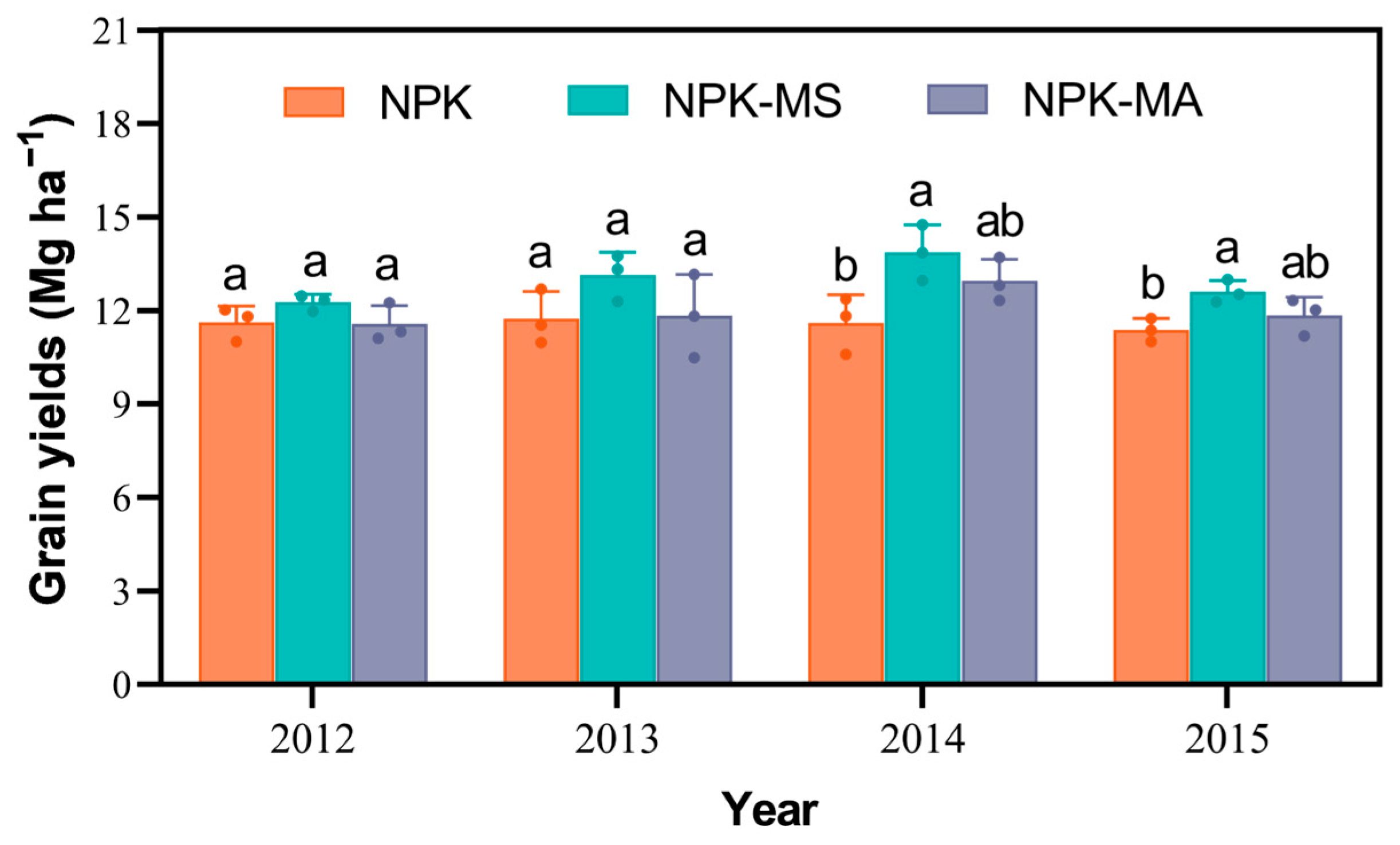
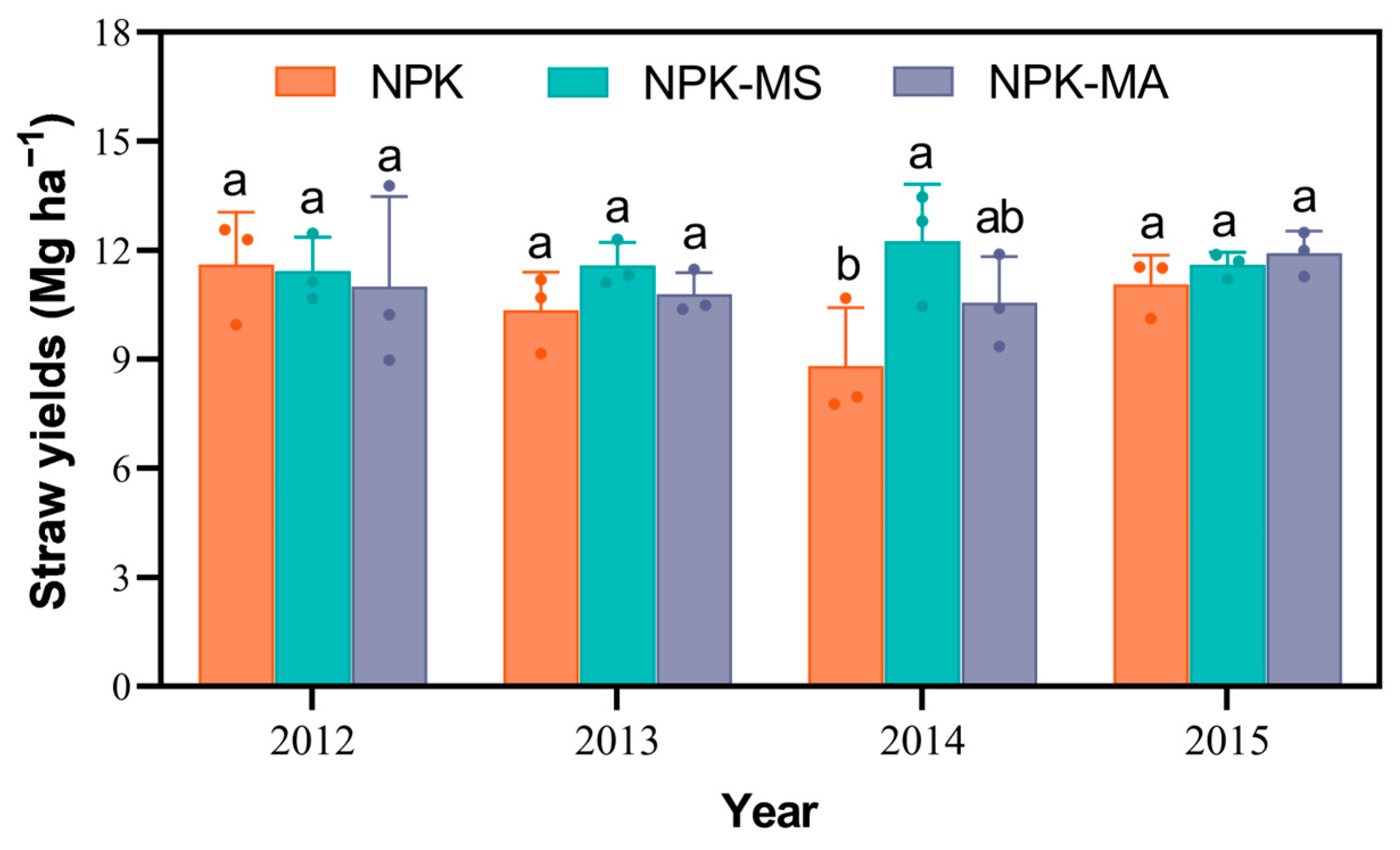
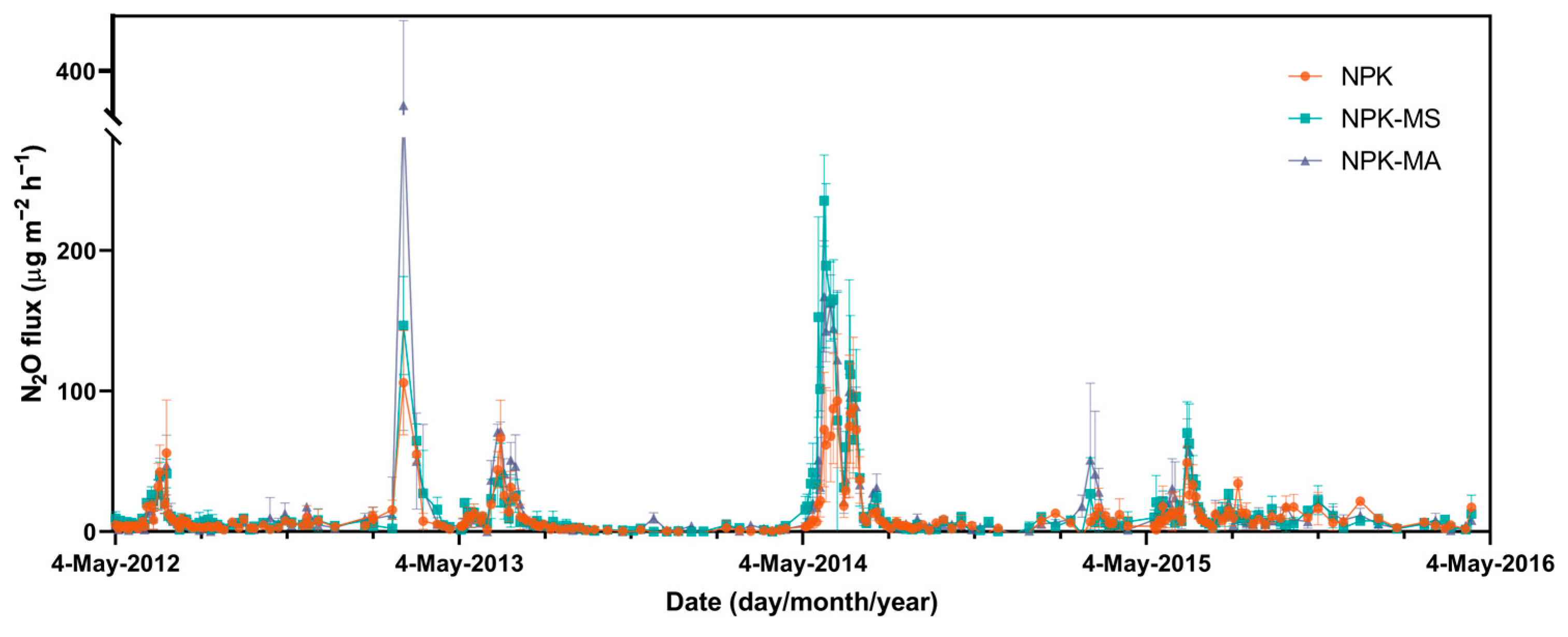
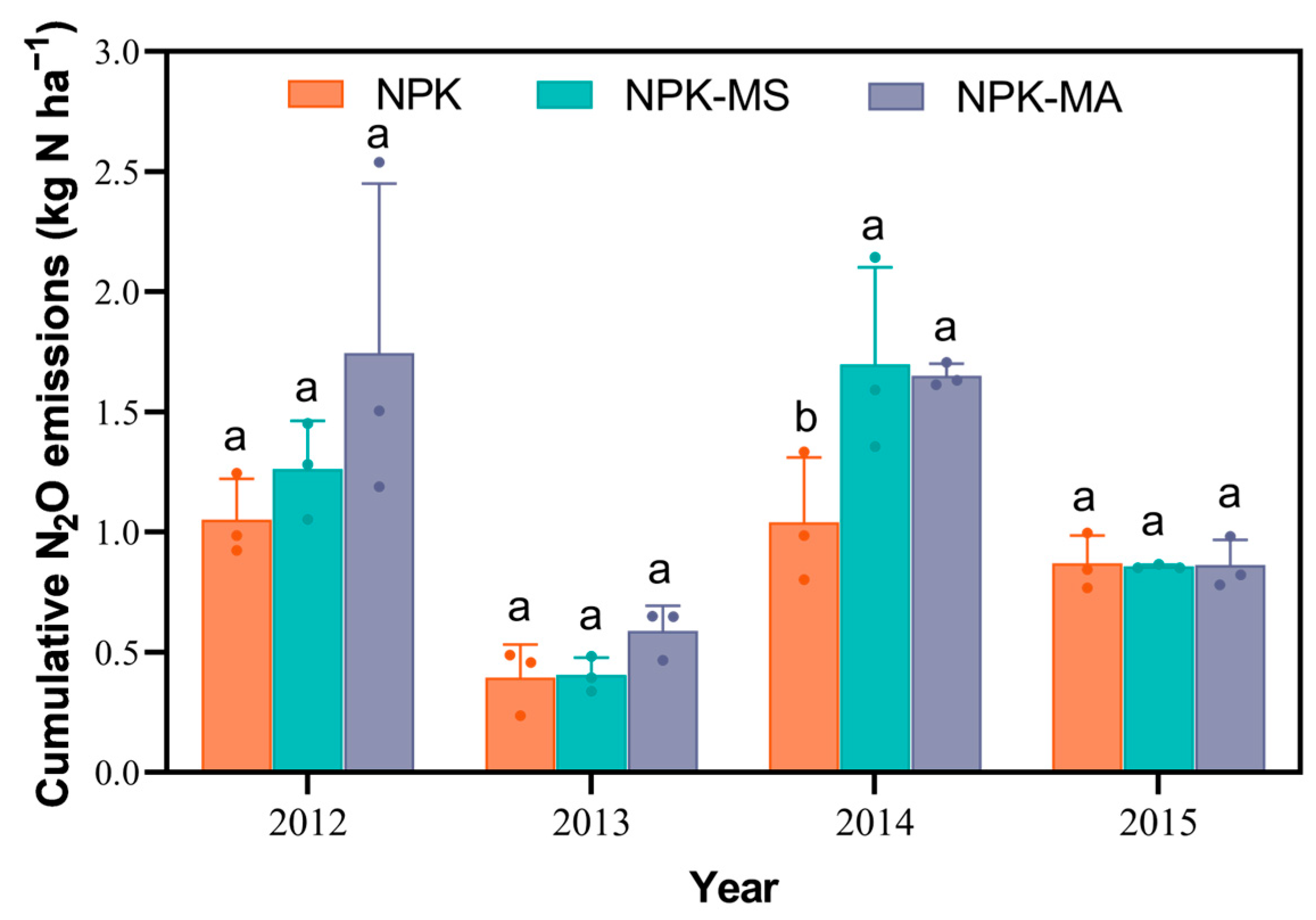

Disclaimer/Publisher’s Note: The statements, opinions and data contained in all publications are solely those of the individual author(s) and contributor(s) and not of MDPI and/or the editor(s). MDPI and/or the editor(s) disclaim responsibility for any injury to people or property resulting from any ideas, methods, instructions or products referred to in the content. |
© 2025 by the authors. Licensee MDPI, Basel, Switzerland. This article is an open access article distributed under the terms and conditions of the Creative Commons Attribution (CC BY) license (https://creativecommons.org/licenses/by/4.0/).
Share and Cite
Dong, D.; Yang, W.; Gao, M.; Gu, J.; Sun, H.; Kong, S.; Xu, H. Effects of Pig Manure Compost Application Timing (Spring/Autumn) on N2O Emissions and Maize Yields in Northeast China. Agronomy 2025, 15, 2487. https://doi.org/10.3390/agronomy15112487
Dong D, Yang W, Gao M, Gu J, Sun H, Kong S, Xu H. Effects of Pig Manure Compost Application Timing (Spring/Autumn) on N2O Emissions and Maize Yields in Northeast China. Agronomy. 2025; 15(11):2487. https://doi.org/10.3390/agronomy15112487
Chicago/Turabian StyleDong, Dan, Weichao Yang, Mingfu Gao, Jian Gu, Hao Sun, Shuang Kong, and Hui Xu. 2025. "Effects of Pig Manure Compost Application Timing (Spring/Autumn) on N2O Emissions and Maize Yields in Northeast China" Agronomy 15, no. 11: 2487. https://doi.org/10.3390/agronomy15112487
APA StyleDong, D., Yang, W., Gao, M., Gu, J., Sun, H., Kong, S., & Xu, H. (2025). Effects of Pig Manure Compost Application Timing (Spring/Autumn) on N2O Emissions and Maize Yields in Northeast China. Agronomy, 15(11), 2487. https://doi.org/10.3390/agronomy15112487






